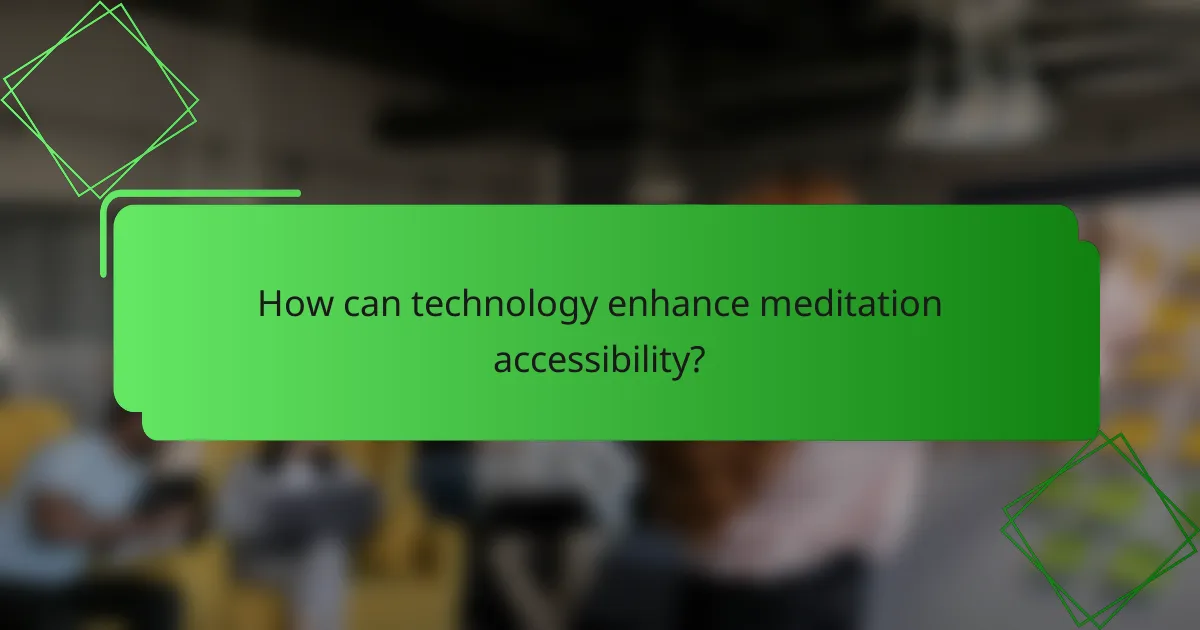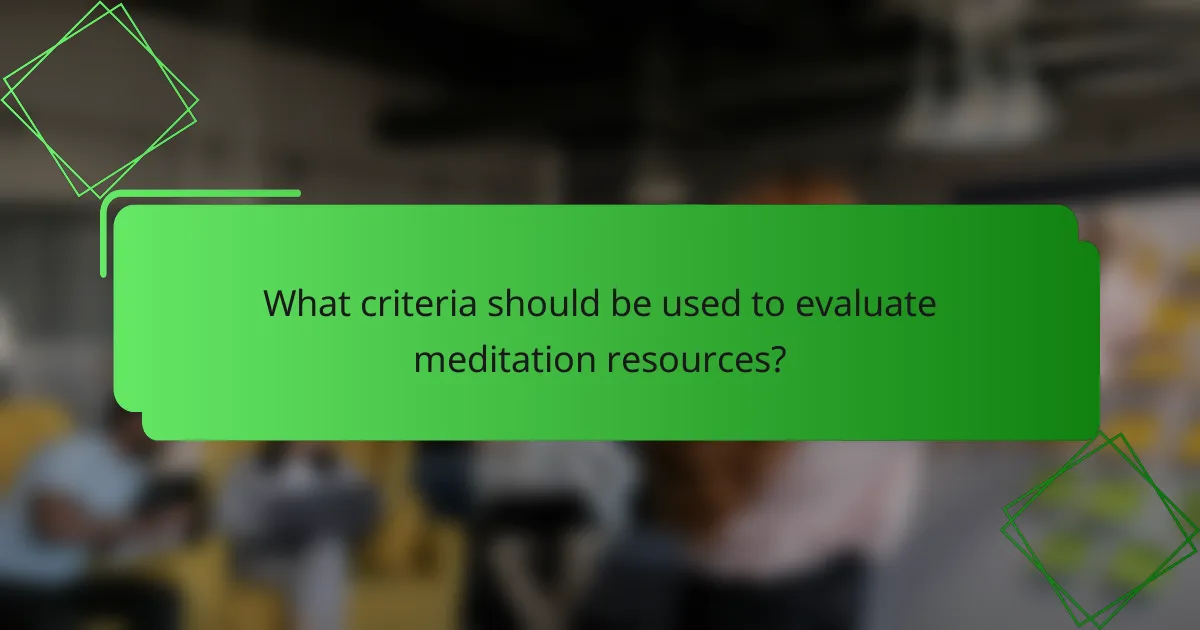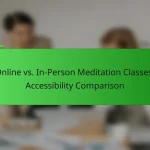Accessible meditation resources play a crucial role in ensuring that individuals with disabilities can experience the benefits of mindfulness and relaxation. From guided audio meditations to specialized apps and centers, these tools are designed to meet diverse needs and enhance emotional well-being. By leveraging technology, meditation becomes more inclusive, allowing everyone to engage in practices that promote mental and emotional health.

What meditation resources are accessible for people with disabilities?
Accessible meditation resources for people with disabilities include guided audio meditations, visual meditation apps, and specialized meditation centers. These resources are designed to accommodate various needs, ensuring that everyone can benefit from meditation practices.
Guided audio meditations
Guided audio meditations are an excellent resource for individuals with disabilities, as they can be accessed from home and tailored to specific needs. Many platforms offer a variety of lengths and themes, allowing users to choose meditations that suit their preferences and schedules.
Look for audio meditations that include features like adjustable playback speed and the option to pause or skip sections. Popular platforms such as Insight Timer and Headspace provide a range of guided sessions that cater to different abilities.
Visual meditation apps
Visual meditation apps can enhance the meditation experience for individuals with visual impairments or those who benefit from visual stimuli. These apps often include calming animations, soothing color palettes, and customizable settings to create a personalized environment.
When selecting a visual meditation app, consider accessibility features such as voice commands, screen reader compatibility, and adjustable contrast settings. Apps like Calm and Breathe offer diverse visual experiences that can be enjoyed by users with various needs.
Accessible meditation centers
Accessible meditation centers provide inclusive environments for individuals with disabilities, offering classes and workshops designed to accommodate different needs. These centers may feature wheelchair access, adaptive seating, and trained instructors who understand how to support diverse participants.
To find an accessible meditation center, check local listings and inquire about their facilities and programs. Many centers also offer online classes, making it easier for individuals to participate from home. Look for centers that prioritize inclusivity and have positive reviews from participants with disabilities.

How can technology enhance meditation accessibility?
Technology can significantly enhance meditation accessibility by providing tailored tools and resources that cater to diverse needs. These innovations help individuals with disabilities engage in meditation practices that may have previously been challenging or inaccessible.
Mobile apps with accessibility features
Mobile apps designed with accessibility features allow users to customize their meditation experiences. Features such as voice commands, adjustable text sizes, and screen reader compatibility make it easier for individuals with visual impairments or mobility challenges to navigate the app.
Popular meditation apps like Headspace and Calm have integrated these accessibility options, ensuring that users can find guided meditations that suit their needs. When choosing an app, look for those that offer free trials to explore their features before committing.
Virtual reality meditation experiences
Virtual reality (VR) meditation experiences can immerse users in calming environments, enhancing the meditation process. These experiences can be particularly beneficial for individuals with mobility limitations, as they allow users to explore serene settings from the comfort of their homes.
Platforms like Oculus and Vive offer various meditation applications that provide guided sessions in visually stunning landscapes. Ensure that the VR system is compatible with any assistive devices you may use, and consider the physical space required for safe movement while using VR.
Adaptive meditation tools
Adaptive meditation tools are designed to meet the specific needs of individuals with disabilities. These tools can include specialized cushions, adjustable seating, or even meditation aids that provide physical support during practice.
For example, weighted blankets can help individuals with anxiety feel more grounded during meditation. When selecting adaptive tools, consider your personal comfort and any specific requirements related to your disability to enhance your meditation experience effectively.

What are the benefits of meditation for people with disabilities?
Meditation offers numerous benefits for people with disabilities, including improved emotional well-being and enhanced cognitive function. By fostering mindfulness and relaxation, meditation can help individuals manage their unique challenges more effectively.
Improved mental health
Meditation can significantly enhance mental health by reducing symptoms of anxiety and depression, which are common among individuals with disabilities. Regular practice encourages a positive mindset and emotional resilience.
Techniques such as guided imagery or loving-kindness meditation can be particularly beneficial. These methods promote self-acceptance and compassion, helping individuals cultivate a more supportive inner dialogue.
Enhanced focus and concentration
Practicing meditation can lead to better focus and concentration, essential skills for navigating daily tasks. Mindfulness meditation, in particular, trains the mind to stay present, which can help reduce distractions.
Simple exercises, like focusing on the breath for a few minutes each day, can improve attention span over time. This practice can be especially useful for individuals with cognitive disabilities who may struggle with maintaining concentration.
Stress reduction techniques
Meditation serves as an effective stress reduction technique, helping individuals manage the pressures associated with disabilities. Techniques such as deep breathing and body scans can lower stress hormone levels and promote relaxation.
Incorporating short meditation sessions into daily routines can create a calming effect. Even a few minutes of mindfulness can help individuals feel more grounded and less overwhelmed by their circumstances.

What criteria should be used to evaluate meditation resources?
When evaluating meditation resources, consider factors such as user reviews, accessibility features, and cost structures. These criteria help ensure that the resources are effective, inclusive, and financially viable for users with disabilities.
User reviews and testimonials
User reviews and testimonials provide insight into the effectiveness and usability of meditation resources. Look for feedback from individuals with disabilities to understand their experiences and any challenges they faced. High ratings and positive comments can indicate a resource’s reliability and accessibility.
Consider checking platforms that aggregate reviews, as they often highlight specific features that users found beneficial or problematic. Pay attention to comments regarding ease of navigation, audio quality, and overall user satisfaction.
Accessibility features and compliance
Accessibility features are crucial for ensuring that meditation resources can be used by individuals with various disabilities. Look for resources that comply with recognized standards, such as the Web Content Accessibility Guidelines (WCAG), which provide a framework for making digital content more accessible.
Key features to consider include screen reader compatibility, captioning for audio and video content, adjustable text sizes, and alternative input methods. Resources that offer these features are more likely to provide a positive experience for users with disabilities.
Cost and subscription models
Cost is an important factor when evaluating meditation resources, especially for users on fixed incomes or with limited budgets. Many resources offer free trials or tiered subscription models, allowing users to select a plan that fits their financial situation.
Compare the costs of different resources, noting what features are included at each price point. Some may offer basic access for free, while premium features might be available for a monthly fee ranging from low single digits to higher amounts. Always check for any hidden fees or cancellation policies before committing.

What are the best meditation apps for accessibility?
The best meditation apps for accessibility include features that cater to users with various disabilities, ensuring an inclusive experience. These apps often provide audio instructions, visual aids, and customizable settings to accommodate different needs.
Insight Timer
Insight Timer is a popular meditation app known for its extensive library of free guided meditations and music tracks. It offers accessibility features such as adjustable playback speed and the ability to filter content based on duration and style, making it easier for users with varying attention spans and preferences.
Additionally, the app includes a community feature where users can connect with others, fostering a sense of belonging. This social aspect can be particularly beneficial for individuals with disabilities seeking support and shared experiences.
Headspace
Headspace is designed with user-friendliness in mind, featuring a clean interface that is easy to navigate. The app provides audio-guided meditations with clear instructions, which can be helpful for users with visual impairments. It also includes a variety of meditation lengths, allowing users to choose sessions that fit their schedules and attention levels.
For those who may have difficulty focusing, Headspace offers themed courses that address specific needs, such as anxiety or sleep issues. This targeted approach can enhance the meditation experience for users with particular challenges.
Calm
Calm is another highly regarded meditation app that emphasizes relaxation and mindfulness. It includes soothing sounds and calming visuals, which can be beneficial for users with sensory sensitivities. The app’s guided meditations are designed to be accessible, with options for different skill levels and durations.
Calm also features a “Sleep Stories” section, providing narrated bedtime stories that can help users with sleep difficulties. This feature can be particularly useful for individuals with disabilities who may struggle with insomnia or anxiety at night.

How can meditation be adapted for different disabilities?
Meditation can be tailored to accommodate various disabilities by modifying techniques and environments to ensure inclusivity. This involves understanding the unique needs of individuals and implementing specific adjustments to enhance their meditation experience.
Modifications for visual impairments
For individuals with visual impairments, meditation can be adapted by using descriptive audio guidance and tactile cues. Practitioners can focus on verbal instructions that emphasize body awareness and breathing techniques, allowing for a deeper connection without visual reliance.
Incorporating sensory elements, such as textured objects or scented candles, can enhance the meditative experience. It’s also beneficial to create a familiar environment, ensuring that participants can navigate their space confidently.
Techniques for hearing impairments
People with hearing impairments can benefit from visual cues and written instructions during meditation sessions. Using sign language interpreters or providing text-based resources can facilitate understanding and engagement in the practice.
Incorporating vibration-based techniques, such as using a meditation cushion that vibrates to signal breathing patterns or mindfulness cues, can also be effective. This allows individuals to connect with the practice through tactile sensations.
Strategies for mobility challenges
For those facing mobility challenges, meditation can be practiced in seated or lying positions to ensure comfort. Utilizing supportive chairs or cushions can help maintain proper posture and relaxation during sessions.
Incorporating gentle movements or stretches can enhance the experience, allowing individuals to engage their bodies without strain. It’s important to encourage participants to listen to their bodies and adjust their positions as needed for optimal comfort and focus.


